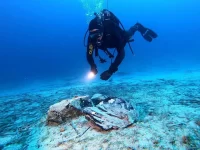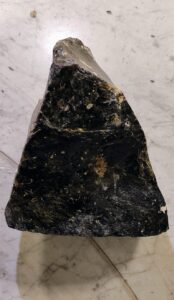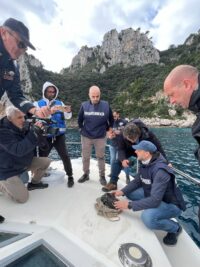 Maritime archaeologists have recovered a block of worked obsidian from a Neolithic shipwreck off the coast of Capri, Italy. Archaeologists from the Superintendency for the Metropolitan Area of Naples recovered the first of a group of worked obsidian cores in a dive on Monday, November 20th. The presence of obsidian blocks in the area had been reported by divers in 2012, but not the specific location. They were located in October near the famous White Grotto of Capri by an underwater unit of the Naples police, and a month later the site was explored by maritime archaeologists.
Maritime archaeologists have recovered a block of worked obsidian from a Neolithic shipwreck off the coast of Capri, Italy. Archaeologists from the Superintendency for the Metropolitan Area of Naples recovered the first of a group of worked obsidian cores in a dive on Monday, November 20th. The presence of obsidian blocks in the area had been reported by divers in 2012, but not the specific location. They were located in October near the famous White Grotto of Capri by an underwater unit of the Naples police, and a month later the site was explored by maritime archaeologists.
 The block they recovered measures approximately 11 by 8 by 6 inches and weighs almost 18 pounds. It bears traces of chiseling and processing, which is how archaeologists know it was trade material, not a random chunk of obsidian that made its way to the seabed on its own.
The block they recovered measures approximately 11 by 8 by 6 inches and weighs almost 18 pounds. It bears traces of chiseling and processing, which is how archaeologists know it was trade material, not a random chunk of obsidian that made its way to the seabed on its own.
No remains of a ship were found, but the dispersal area of the obsidian was much larger than reported and at a depth of between 100 and 130 feet. That indicates the blocks were the cargo of a lost ship. The
Superintendency is planning an extensive instrumental survey of the seabed to look for the possible hull and any other cargo material around the find site.
The obsidian block was transferred to a warehouse of the Superintendency and awaits cleaning and conservation. Conservators will remove the concretions on its surface to analyze the block in detail.
 It was in the Neolithic that obsidian began to be used to create sharp weapons and cutting tools. It chips as easily as flint, but creates a sharper edge. In the late 19th century, a major cache of obsidian blocks and more than 800 finished obsidian objects was discovered on a private estate in Capri. They were the remains of a 7,000-year-old obsidian cutting workshop. Recent analyses of those obsidian materials determined they originated in Lipari, a volcanic island in the Aeolian Archipelago north of Sicily whose rich obsidian flows were extensively quarried by Neolithic communities. The presence of Lipari obsidian in Capri is evidence there was an active trade over land and sea.
It was in the Neolithic that obsidian began to be used to create sharp weapons and cutting tools. It chips as easily as flint, but creates a sharper edge. In the late 19th century, a major cache of obsidian blocks and more than 800 finished obsidian objects was discovered on a private estate in Capri. They were the remains of a 7,000-year-old obsidian cutting workshop. Recent analyses of those obsidian materials determined they originated in Lipari, a volcanic island in the Aeolian Archipelago north of Sicily whose rich obsidian flows were extensively quarried by Neolithic communities. The presence of Lipari obsidian in Capri is evidence there was an active trade over land and sea.
* This article was originally published here











No comments:
Post a Comment